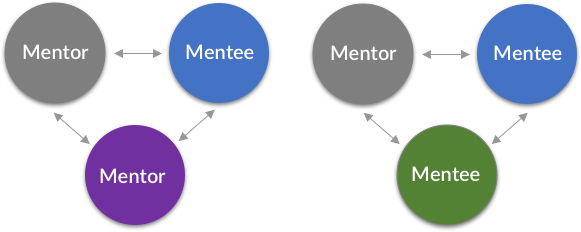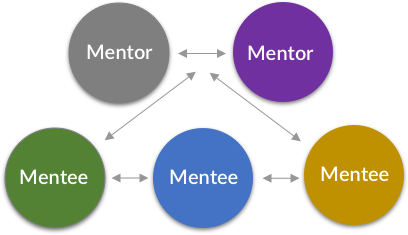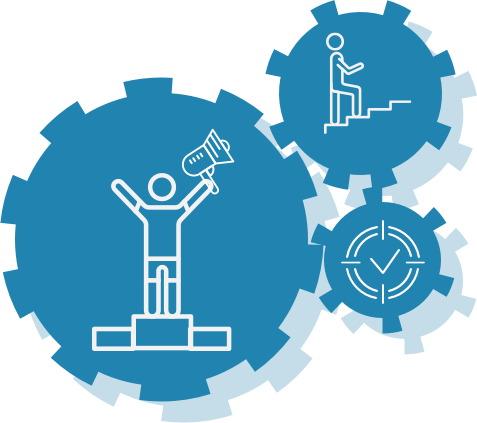Mentorship Functions
Psychosocial Support
Mentor encourages mentee, helps with problem-solving, uses active-listening techniques1
- Mentor serves as a guide for mentee’s behavior, values, attitudes
- Mentee benefits from engaging with mentor who share values and deep-level similarity with them7
- Allows mentees to see themselves as future academics
Career (Instrumental) Support
Mentor provides support for assessing and choosing an academic and career path by evaluating mentee’s strengths, weaknesses, interests, and abilities. Mentor’s role include:
- helping mentee reflect and think critically about goals2;
- facilitating mentee’s reflection on and exploration of their interests, abilities, beliefs, and ideas3;
- reviewing mentees’ progress toward goals;
- challenging mentee’s decisions or avoidance of decisions4; and
- helping mentee to realize their professional aspriations.5
Mentor educates, evaluates, and challenges mentee academically and professionally; tutors or provides training; and focuses on subject learning6
Mentor publicly acknowledges the achievements of the mentee and advocates for the mentee.
Forms of Mentorship
Hover/click to read more
Dyad

Dyadic pairing between and one mentor and one mentee with bidirectional engagement.
Triads

Two examples of triads, one open triad with two mentors and one mentee (co-mentorship) and one closed triad with one mentor and two mentees; both with all bidirectional engagement.
Collective or Group

An example of a collective or group mentorship configuration with two mentors and three mentees and bidirectional engagement.
Network

An example of a mentorship network for a mentee with two mentors, two mentorship nodes (i.e., a group of peer mentors), and two resource modes (i.e., a mentorship-intensive social media forums).
Mentoring relationships can occur in formal, structured, and intentional settings or as informal, organically developed relationships that mentees develop with more experience individuals with whom they have regular contact (Inzer and Crawford, 2005). Mentoring relationships can include:
- A single mentor working with a single mentee in a classic dyadic relationship
- A group of mentors sharing their collective wisdom with one mentee
- One mentor working with multiple mentees
- Peer and near-peer mentoring structures
- Online peer communities
- Programmatic mentoring
- Mentoring experiences delivered through carefully constructed short-term seminars, workshops, or presentations.
Formal and Informal Mentorship
Formal mentorship refers to mentoring relationships or programs in which an individual or program has specific responsibilities related to the progress and success of the mentee, and where the parties are formally assigned and expected to engage in mentorship. Such relationships may include an evaluative or supervisory function in which the mentor is responsible for overseeing and evaluating the mentee’s progress and success, such as in a primarily research context in STEM.
Informal mentorship refers to mentoring relationships that evolve spontaneously and informally (Ragins and Cotton, 1999), with no specified responsibilities and involve no evaluative or supervisory function.
Mentorship Dyads
For the most part, mentorship has been studied as a dyadic structure, meaning relationship between a single mentor and mentee working together as a pair. This dyadic perspective on mentorship is sensible in terms of both research and practice. Historically, the process of developing expertise and career preparation has followed an apprenticeship model in which a novice learns by working alongside an expert (Lave and Wenger, 1991; Wenger, 1999). This apprenticeship structure is still standard in some STEMM learning environments, such as undergraduate and graduate research and in clinical internships and residencies. However, this paradigm is changing.
Non-Dyadic or Multiple-Mentor Mentorship
A single mentor might not have the entire suite of knowledge, skills, abilities, or connections needed by their mentee (DeCastro et al., 2013; Halvorson et al., 2015; Yun et al., 2016). Therefore, other mentorship structures beyond dyads may be important for mentees’ success. Although most research on mentorship in STEMM examines mentorship at the level of dyads, a more diverse set of configurations are used in practice.
Mentoring Triads
Mentorship triads can include one mentee and two mentors, two mentees and one mentor, or a combination of the two. In this combined configuration, the most experienced individual in the triad mentors a somewhat less experienced individual, who in turn mentors an individual who is new to the field or area, forming a sort of mentorship cascade or ladder. In some instances, mentorship triads may function with three-way interactions characterized by trust and responsiveness, providing career and psychosocial support. This is sometimes described as a “closed” triad. In other instances, mentorship triads may function more as adjoining dyads, with interactions between pairs of individuals in the triad. This structure has been described as an “open” triad.
Mentorship, Identity, and STEMM
What is Identity?
Aspects of identity such as race, ethnicity, gender, income, and first-generation status are particularly important factors in retention and success in college and in STEMM fields
Identity is the composite of who a person is. It includes the way one thinks about oneself, the way one is viewed by the world, and the characteristics that one uses to define oneself, such as an individual’s gender identification, sexual orientation, place of birth, race, ethnicity, first-generation college status, profession, values, and even hobbies (Crenshaw, 1991; Felix-Ortiz et al., 1994; Hall and Burns, 2009; Hall, 2014; Helms, 1990; Jones and McEwen, 2000; Nash, 2008; Sellers et al., 1998; Shields, 2008). Some aspects of identity are constant, while others change depending on stage of life and social context. In addition, a person can hold multiple identities that also intersect, such as Black, transgender woman, scientist, spouse, parent, artist, bookworm, and athlete. Research on the persistence of underrepresented (UR) populations often highlights specific aspects of identity such as race, ethnicity, gender, income, and first-generation status as particularly important factors in retention and success in college and in STEMM fields (Archer et al., 2010; Barton et al., 2013; Kim et al., 2018; Merolla and Serpe, 2013; Stephens et al., 2014). Identity can also govern access to social capital and network resources, and impact power in relationships.
How Does Mentorship Help Develop Science Identity?
Mentors need to understand how various identities interact with one another in their mentees
By contributing to the socialization and integration of students into scholarship and academe as a community, effective mentorship plays a critical role in developing a science identity (Byars-Winston et al., 2015; Eagan et al., 2011; Eby and Dolan, 2015; Estrada et al., 2018; Freeman, 1999; Gandara and Maxwell-Jolly, 1999; Gasiewski et al., 2012; McGee and Keller, 2007; Robnett et al., 2018; Thiry and L. Laursen, 2011), which then makes it more likely they will continue on in STEM fields after graduation (Barlow and Villarejo, 2004; Estrada et al., 2011). Mentorship also helps students see themselves as STEMM scholars who can contribute to their disciplines (Wilson et al., 2012). Given that developing a science identity is a strong predictor of who will continue on to graduate school in a STEM fields, colleges and universities should enable experiences that help undergraduates feel they belong in and are included in the scientific culture, which in turn will help foster the development of a strong science identity and increase retention rates in STEM for underrepresented undergraduate students (Estrada et al., 2018).
The psychosocial support functions of mentorship have been found to influence science identity for graduate student mentees (Chemers et al., 2011). Given that self-efficacy and science identity need to mesh with other aspects of social identity (Bakken et al., 2010; Hunter et al., 2007; Ries et al., 2009), mentors need to understand how various identities interact with one another in their mentees. Mentors should also accept that the identities of their mentees will likely evolve as they progress toward becoming STEMM professionals and continually assess their competence as STEMM professionals.
How Does Identity Influence Mentorship?
Mentors in STEMM fields are typically White or Asian, and research shows that majority mentors are more likely to hold “colorblind” views of their students and to dismiss the idea that social identities shape their students’ academic experiences (Brunsma et al., 2017; McCoy et al., 2015; Prunuske et al., 2013). Some STEMM faculty from well-represented groups may espouse this ideology due to concerns of being misunderstood by or offensive to their mentees, not knowing what to say, or even fear of being perceived as prejudiced (Byars-Winston et al., In press). Some underrepresented faculty in STEMM, especially those at predominantly White institutions, may be likewise disinclined to directly address social identities and cultural diversity matters because of their own experiences with inequities in institutional roles and research support (Armstrong and Jovanovic, 2017; Xu, 2008). However, based on the evidence, to ignore race, gender, and other important social identities is to deny the formative effect of these identities on students’ experiences in their programs and later careers.
Avoid colorblind views including focusing exclusively on the performance measures of the individual without consideration factors that are highly correlated with their social identities such as their background and additional social context. This tends to privilege individuals with better preparation, higher social capital, and fewer additional obligations—often White, male, single, full-time, non-first-generation students from higher socio-economic backgrounds.
Culturally Responsive Mentorship
Culturally responsive mentorship can validate students’ various identities and help them navigate invalidating experiences encountered while simultaneously reinforcing their self-efficacy in their field
Culturally responsive mentoring correlates with students feeling more connected to their field of study and research. Mentors from all backgrounds can to work acknowledge identities of their mentees and understand the research describing the impact of social identities on students’ experiences in STEMM. Studies have found that mentors who were culturally responsive—who had attitudes, behaviors, and practices that enable them to work with mentees with different cultural backgrounds (Sanchez et al., 2014)—and who understood power dynamics and oppression had success in fulfilling the needs of underrepresented students (Felder and Barker, 2013; O'Meara et al., 2013). Culturally responsive mentorship can validate students’ various identities and help them navigate invalidating experiences encountered while simultaneously reinforcing their self-efficacy in their field (Byars-Winston et al., 2010). This can greatly increase the likelihood of their thriving in STEMM environments (Thomas et al., 2007; Vaccaro and CambaKelsay, 2018).
When culturally responsive mentors show curiosity and concern for students’ cultural backgrounds and their non-STEMM social identities it can validate their students’ multiple identities. A study of underrepresented undergraduate STEMM students revealed that those reporting that they had received culturally responsive mentoring felt more confident as a researcher, refined their academic and career goals, and became more committed to graduate school and a graduate degree (Haeger and Fresquez, 2016). Scholars who work on diversifying STEMM stress that faculty can improve their mentorship by considering contexts, styles, and the lived experiences of students—including their social and science identities—in supporting students’ values and goals (Cropps and Esters, 2018; García and Henderson, 2014; Mondisa, 2015; Patton, 2009; Rasheem et al., 2018; San Miguel and Kim, 2015).
Negative Mentoring Experiences
While there is an understandable focus on effective and positive mentoring relationships, programs, and behaviors, mentorship scholars acknowledge that mentorship quality exists on a continuum (Ragins et al., 2000). Mentorship can include dysfunctional elements or problematic events that are collectively referred to as “negative mentoring experiences” (Eby et al., 2000; Kram, 1985a; Scandura, 1998; Simon and Eby, 2003). Negative mentoring experiences can refer to problematic aspects of an otherwise positive relationship and do not necessarily mean that the entire relationship is negative or harmful (Kram, 1985a; Scandura, 1998; Simon and Eby, 2003).
Types of Negative Mentoring Experiences

Because of the potential for dysfunctional mentorship to cause harm, additional research to better understand the prevalence and impact of negative mentoring experiences in STEMM education is necessary. Mentees who experience negative mentorship in the workplace report lower job satisfaction, higher likelihood of leaving their employer, and increased stress (Eby and Allen, 2002; NASEM, 2018b). These undesirable outcomes may result from mentee perceptions that the job, the organization, or the career may not be the right fit (Burk and Eby, 2010; Kristof, 1996; Su et al., 2015). In fact, one study found that workplace negative mentoring experiences may be so damaging that mentees who experience it may be worse off than if they had no mentor at all (Eby et al., 2010). In the case of one specific type of negative mentoring experiences—sexual harassment—numerous studies have shown that sexual harassment results in declines in professional and psychological well-being, including withdrawing from engagement with work, having thoughts of quitting or actually quitting a job, physical complaints (such as headaches, exhaustion, and sleep disruption), and symptoms of depression, disordered eating, stress, anxiety, and post-traumatic stress disorder (Eby and Allen, 2002; NASEM, 2018b).
Negative mentoring experiences may be particularly harmful for mentees from underrepresented backgrounds given the facilitative role that mentored research experiences can have in the success of STEMM underrepresented groups. For example, studies investigating positive outcomes of mentorship have shown that undergraduate mentored research experiences in STEMM are particularly beneficial for UR at-risk students (Estrada et al., 2018; Thiry and L. Laursen, 2011). Furthermore, the effectiveness of undergraduate mentored research for underrepresented students may hinge on the capacity of these experiences to promote a sense of fit with the scientific community (Estrada et al., 2017; Estrada et al., 2011; Hurtado et al., 2009; Hurtado et al., 2011). Therefore, negative mentoring experiences may disproportionately harm these students. Future research should address this more directly by defining and characterizing negative mentoring experiences in STEMM and investigating its prevalence and impacts.





